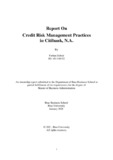| dc.contributor.advisor | Debnath, Nitai Chandra | |
| dc.contributor.author | Zubair, Farhan | |
| dc.date.accessioned | 2021-10-26T06:35:32Z | |
| dc.date.available | 2021-10-26T06:35:32Z | |
| dc.date.copyright | 2021. | |
| dc.date.issued | 2021-01 | |
| dc.identifier.other | ID: 18164052 | |
| dc.identifier.uri | http://hdl.handle.net/10361/15551 | |
| dc.description | This internship report is submitted in partial fulfillment of the requirements for the degree of Masters of Business Administration, 2021. | en_US |
| dc.description | Cataloged from PDF version of internship report. | |
| dc.description | Includes bibliographical references (pages 35-37). | |
| dc.description.abstract | Banking system of Bangladesh has been developed through three stages including
nationalization, privatization and financial sector reform. Citibank, N.A., Bangladesh (Citi) has
started its journey as a representative office in 1987 and as full service branch in 1995 (Industry,
n.d.). Citibank, N.A. follows the rules and regulation imposed by the central bank of
Bangladesh, Bangladesh Bank (BB). To manage credit risk, Citi determines individual credit
limits to the clients and obtains adequate collaterals as required. Credit risk in Citi is monitored,
evaluated and examined by Credit Risk Management Services (CRMS). Citi has developed
Asset-Liability Management Committee (ALCO) to decide the maximum credit risk exposure.
Senior management is constantly updated about the guidelines of BB and has executed new
capital requirement according to BASEL-III. As I have completed my internship in CRMS, to
determine the efficacy of credit risk management (CRM) practices, key aspects including the
process of CRM, credit risk faced by Citi along with the tactics to mitigate the risk are analyzed
in a broad manner. The credit risk management practices of Citi found to be estimable.
However, the document requirement list and the credit limit approval process is a bit lengthy
compared to today’s fast moving world. Strict and constant monitoring along proper
documentation of the credit portfolio is the key for such praiseworthy status. Although the bad
loans are below 2% of the total loan portfolio, Citi should be vigilant and emphasize to reduce
or not at least increase the classified and non-performing loans (NPL), especially at this critical
time of COVID 19. | en_US |
| dc.description.statementofresponsibility | Farhan Zubair | |
| dc.format.extent | 80 Pages | |
| dc.language.iso | en_US | en_US |
| dc.publisher | Brac University | en_US |
| dc.rights | Brac University Internship reports are protected by copyright. They may be viewed from this source for any purpose, but reproduction or distribution in any format is prohibited without written permission. | |
| dc.subject | Banking System of Bangladesh | en_US |
| dc.subject | Credit Risk Management | en_US |
| dc.subject | Citibank | en_US |
| dc.title | Credit risk management practices in Citibank, N.A. | en_US |
| dc.type | Internship report | en_US |
| dc.contributor.department | Brac Business School, Brac University | |
| dc.description.degree | M. Business Administration | |

